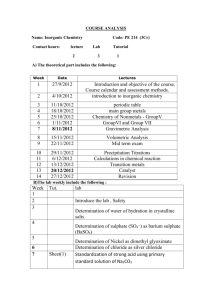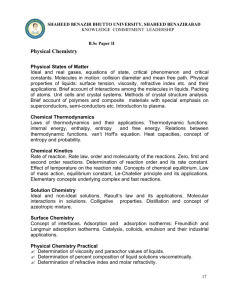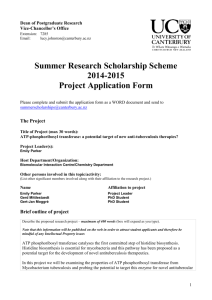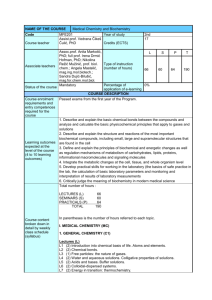Agric. Chemistry
advertisement
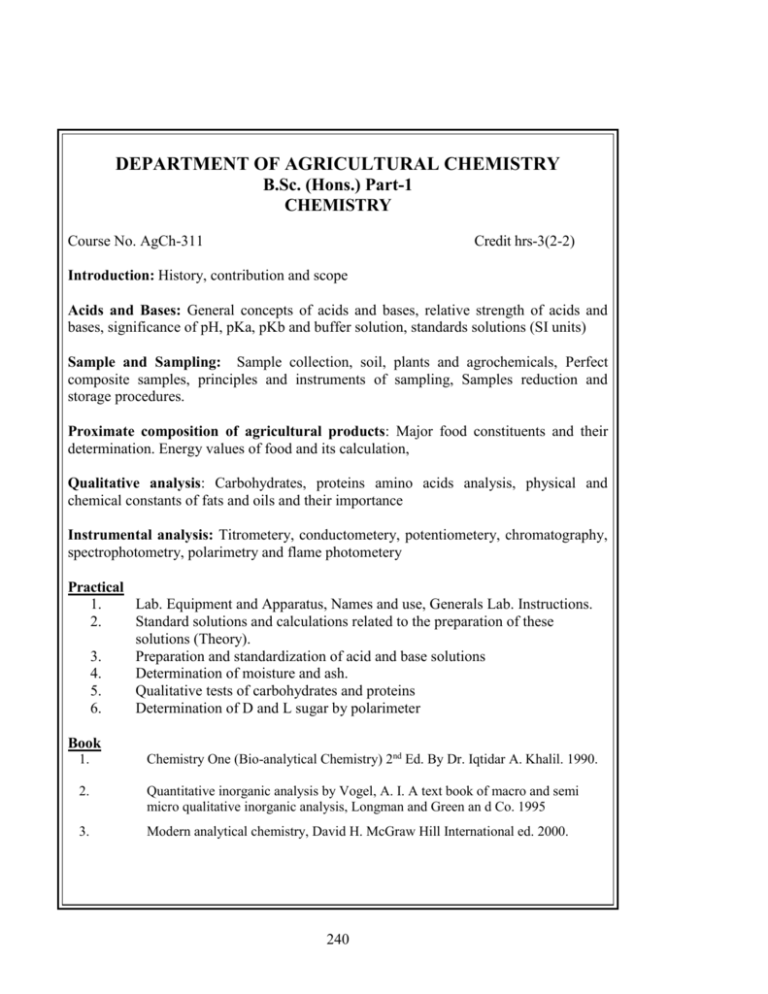
DEPARTMENT OF AGRICULTURAL CHEMISTRY B.Sc. (Hons.) Part-1 CHEMISTRY Course No. AgCh-311 Credit hrs-3(2-2) Introduction: History, contribution and scope Acids and Bases: General concepts of acids and bases, relative strength of acids and bases, significance of pH, pKa, pKb and buffer solution, standards solutions (SI units) Sample and Sampling: Sample collection, soil, plants and agrochemicals, Perfect composite samples, principles and instruments of sampling, Samples reduction and storage procedures. Proximate composition of agricultural products: Major food constituents and their determination. Energy values of food and its calculation, Qualitative analysis: Carbohydrates, proteins amino acids analysis, physical and chemical constants of fats and oils and their importance Instrumental analysis: Titrometery, conductometery, potentiometery, chromatography, spectrophotometry, polarimetry and flame photometery Practical 1. Lab. Equipment and Apparatus, Names and use, Generals Lab. Instructions. 2. Standard solutions and calculations related to the preparation of these solutions (Theory). 3. Preparation and standardization of acid and base solutions 4. Determination of moisture and ash. 5. Qualitative tests of carbohydrates and proteins 6. Determination of D and L sugar by polarimeter Book 1. Chemistry One (Bio-analytical Chemistry) 2nd Ed. By Dr. Iqtidar A. Khalil. 1990. 2. Quantitative inorganic analysis by Vogel, A. I. A text book of macro and semi micro qualitative inorganic analysis, Longman and Green an d Co. 1995 3. Modern analytical chemistry, David H. McGraw Hill International ed. 2000. 240 BIOCHEMISTRY Course No. AgCh-411 Credit hrs- 3(2-2) Introduction to Biochemistry: Scope and fields of biochemistry, Biochemical Unity, Application of Biochemistry Carbohydrate: Biological importance of Carbohydrates. Classification, Structures and reactions of monosaccharids, some oligosaccharides and polysaccharides, Lipids: Biological importance, Classification, fatty acids, triglycrides, Phospholipids, arytenoids and Steroids, Properties of fat/oils Proteins and Amino Acids: Biological importance, classification, structure and characteristics of proteins, essential amino acids. Enzymes: Enzymes terminology, nomenclature, Classification, nature and specificity of enzymes, Factor affecting enzymes activity. Vitamins: Introduction, Classification, deficiency symptoms of vitamins and sources A, D, E, K, B-complex and Vita-C Minerals: Classification, deficiency symptoms and sources of Calcium, Phosphorus, Iron, Zinc, Iodine and Magnesium. Practical 1. 2. 3. 4. 5. 6. Determination of Reducing Sugars by volumetric method. Determination of Non-reducing Sugars by volumetric Method. Determination of Acid value. Determination of Saponification value. Determination of Protein by Kjeldahl method. Determination of Vitamin-C by dye reduction method. Text Books 1. Basic Biochemistry, Iqtidar A. Khalil and H. Shah, National Book foundation Islamabad (2002). 2. Essential of Biochemistry, Dr. Muhammad Rafique Khan 1981. 3. Biochemistry, L. Stryer, W. H. Freeman and Co. 5th ed. 2002. 4. Biochemistry, Zubay G., Brow Dubuque, Lowa, 4th ed. 1998. 241 5th Semester APPLIED BIOCHEMISTRY Credit hrs –4(3-2) Course No. Agch-501 Fermentation processes; Anaerobic and Aerobic, Manufacture of antibiotics, vitamins, and steroids by microbial processes, Oils and Fats: Occurrence, structure, extraction, refining, hydrogenation and rancidity. (Food-by-product) and utilization; Vegetable and animal gelatin,. Microencapsulation in food industry. Introduction, properties, uses, ingredients and techniques. Light microscopy in Food Analysis, Introduction, Specimen preparation, physical method of obtaining contrast, histochemical staining, iodine vapour, staining for starch, Osmium tetroxide vapour, Combined vapor staining of lipids and starch, Starch: preparation, modification and application in food. PRACTICAL 1. 2. 3. Determination of saponification value, Acid value, Iodine value and R.M & Polenske value. Determination of Vitamin A and Vitamin C in food and food products. Staining methods: Starch, lipid. BOOKS RECOMMENDED 1. 2. 3. 4. 5. 6. 7. Konddo, A. Microcapsules, Processing and technology. New York NY. Marcel Dekker, Inc. 1989. Olga, Flint, Food Microscopy, 1994. Principles of Biochemistry. Albert L. Lehninger. The John Nophins University School of medicine. Worth Publishers, INC-year 1993. Chemistry and Chemical industry, smiley, Publisher, R.A. CRC. 2002 Kent, J.A. Riegal’s handbook of Industrial chemistry. CBS Publishers and Distributors, New Delhi, 1997. Smith, R., Chemical Process Design, McGraw Hill Book Co. New York, 1995. Lehninger, A.L. Principles of Biochemistry, worth Publisher, New York 2001. 242 VITAMIN AND MINERALS Course No. AgCh-502 Credit hrs - 4 1. Vitamins Historical review, classification, structure, physiological functions, deficiency diseases, sources and recommended dietary allowances (RDA) of vitamin A, D, E, K and B-Complex (B1, B2, B5, B6, B12) and Ascorbic Acid. 2. Minerals Macro and micro nutrients, their role in the body, sources, RDA and diseases associated with the deficiency of calcium, phosphorus, Iron, Iodine, Zinc, Cu, Mn, Mg, K. PRACTICAL 1. 2. 3. 4. 5. Determination of vitamin A by spectrophotometer/HPLC Determination of vitamin C by Dye titrimetric method Determination of phosphorus in food/feed by spectrophotometer Determination of micron ting chemistry Zm, Cu, AAS). Determination of Cu, Na, Mg. K by flame photometry in food. Books Recommended 1. 2. 3. 4. 5. 6. Fat soluble vitamin by Morton, R.A. Ed. (1970). Proganon Press New York. Biochemistry by Metzier, M.S. (1979). Academic Press, New York. Principle of Biochemistry by White, A. et al (1978). 6th Edn. MacGraw Hill, New York. Hand book of Vitamins by Lawrence J. Machlin (1984). Marcel Dekker New York USA. Mendham, J.R.C. Denny, J.D. Barnes and M. Thomas, Vogels Text Book of Quantitative Chemical analysis, 6th Edition Prentice Hall (2000). Skoog D.A, DM West and F. J. Holler, Fundamentals of Analytical Chemistry, 6ths Edition, Saunders College Publishing Co. (1992). 243 CHEMISTRY OF FATS AND OILS Course No. AgCh-503 Credit hrs: 4 INTRODUCTION: Composition and classification of dietary fats and oils. 1. Fatty acids Nomenclature, saturated and unsaturated fatty acids, essential and non-essential fatty acids. 2. Properties of fats and oils Melting point, refractive index, hydrogenation, hydrolysis, halogenation, saponification and rancidity of fats and oils. 3. Metabolism of Fat and Oils Digestion, Absorption and Transport of fats. Oxidation of fatty acid, Formation of ketone bodies, Biosynthesis of fats, phospholipid and cholesterol. 4. Dietary Fat and Health Plasma lipoproteins, low density lipoprotein (LDL) and high density lipoprotein (LDL), their association with coronary heart diseases (CHD). Effect of dietary fat on health such as obesity, hypertension, diabetes, cancer etc and immune response system. Recommended level of different types of dietary fat. Practical 1. Determination of iodine value, R.M. value, and Polenske value 2. Determination of the melting point of fat. 3. Fatty acid determination by GLC 4. Cholesterol determination of spectrophotometric method Text Books 1. I.A. Khalil, Basic Biochemistry. National Book Foundation, Islamabad (1998). 2. Compbell, M.K. Biochemistry. Saunders College Pub. Philadelphia (1991). 3. Kroschwitz,J.I. and Winokur, M. Chemistry - General, Organic, Biological. 2nd Edn, McGraw Hill, Inc, New York (1990). Reference Books 1. FAO.WHO Fats and Oils. FAO. Food and Nutrition paper 57. Rome (1994). 2. Mead, J.F. et a.. Lipids Chemistry, Biochemistry and Nutrition. Plenum Press, London (1986). 3. Vergroesen, A.J. and Crawford. The role of fat in Human Nutrition. 2nd Ed. Academic Press, London (1989). 244 BIO-ORGANIC CHEMISTRY Course No. AgCh- 504 (3-2) Credit hrs-4 1. Introduction to bioorganic chemistry: 2. Chemistry of natural products and biosynthesis: Organic matter (Cellular, hemi cellular hum acid, ligm 3. Stereochemistry and general conformational analysis: 4. Chemistry of nucleic acid, carbohydrates, protein, and heterocycles 5. Chemistry and application of protective group. 6. Chemistry of phosphorus containing compounds: Amino and lipid, acids, and sulpher. 7. Conformation of nucleic acid, carbohydrates and proteins and their interactions 8. Enzyme engineering, molecular mechanics Practicals 1. Synthesis Iodoform and aspirin. 2. Chemical reactions of ketone. 3. Qualitative and quantities determination of alkaloids (nitrogen containing compounds (nicotine, caffeine, etc). 4. Tests for Natural Products (naphthalene, quinone etc) Textbooks 1. 2. 3. 4. 5. 6. 7. 8. 9. Bioorganic Chemistry by H. Dugas and C. Penny; Principles of Nucleic Acid Structures by W, Saenger Biological Chemistry by C.J Sucklings Organic Chemistry: Vol.I 6th Ed. And Vol. II 5th Ed. By I.L. Finar. Longman Green and Co. London (1995) Volhart. Organic Chemistry with (CD), 1995. Harris. Quantitative chemical analysis with (CD), 2001. Bansel. R.K. Heterocyclic chemistry, weig Eastern Ltd. New Delhi 2001. Stereochemistry: Introduction: Optical Isomerism, Optical activity, methods of determing configuration, recemicmixtures Geometrical isomerism: Determination of configuration of geometrical isomers. Citrons isomerism in cyclic systems. Conformational isomerism. Stereo-chemistry of Carbon compound McGraw Hill, London. 245 6th Semester BIO-PHYSICAL CHEMISTRY Course No. AgCh-511 1. 2. Credit hrs - 4 Acids, Bases Introduction & Scope:Modern concepts of acids and bases. pH, its measurement. Buffers and their role in biological system, Electrophori. Osmosis Osmotic pressure, determination of osmotic pressure. Isotonic, Hypotonic and Hypertonic solutions. Role of osmotic pressure in fluid exchange of biological system. 3. Colloids and polymers: Nature and characteristic of colloids, Purification of colloidal solutions. Application and uses. 4. Adsorption isotherm and viscosity Biophysical phenomena, Adsorption, viscosity and surface tension, principles of Adsorption, determination of viscosity and surface tension. PRACTICAL 1. 2 3 4. 5. 6. Determination of surface tension by stalagmometer, Dete.of M.Wt by Osmosis. Determination of viscosity by viscometer. Determination of pH value by potentiometer method. Potentiometric titration of acids and bases. Determination of refractive index by a refractometer. Adsorption of Acetic acid on Charcoal. Books Recommended 1. Physical Chemistry. A. J Mee. English Book Society London (1969). 2. Essential of Physical Chemistry. Bahl and Tuli Chand Co. Delhi (1984). 3. Physical Chemistry. Khetarpal Chand Co. Delhi, (1985). 7. Biochemistry Vol. I by Dr. M. Rafiq Khan 1981. 8. Biophysics, Cotterill, R.M.J. John Wiley. 2002 Reference Books Physical Chemistry. Samuel Gladstone. MacMillan and Co. Limited, London (1980). Atkins P.W & M.J. Cluster, Principles of by Pitman Publishing Co. 1998. 246 PROTEIN CHEMISTRY Credit hrs – 4 (3-2) Course No. AgCh-512 1. Introduction: Classification of Structural and functional proteins. 2. Protein Structure Primary, secondary, tertiary and quaternary structures. 3. Amino Acids Structure, classification and properties of amino acids. Essential amino acids, and their occurrence in food animal and plant origin. 4. Protein Characteristics Properties and reaction of protein. Solubility, optical activity, dialysis, ultra centrifugation, electrophoresis, precipitation and hydrolysis of proteins. 5. Protein Quality Evaluation Amino acid score with reference to FAO/WHO standard. Deficient Amino acids score in foods. Protein efficiency ratio (PER), net protein utilization (NPU) and biological value (BV) of protein. Nitrogen balance (NB). PRACTICAL 1. Crude protein determination by Kjeldahl and spectrometric by formal titration. 2. Determination of protein by farmol titration. 3. Preparation of protein hydrolysate. 4. Amino acid determination by paper and ion-exchange chromatography. 5. Quantitative estimation of amino acids by ninhydrin method. 6. Determination of PER, NPU, BV by Bioassay methods. Text Books 1. Creighton, T.E. Proteins. W.H. Freeman and Co. San Francisco, California, USA (1985). 2. Campbell, M.K. Biochemistry, Saunders college Pub. Philadelphia (1991). 3. Khalil. I.A, Basic Biochemistry, National Book Foundation, Islamabad (1991). 9. Conn and Stump, Outline of Biochemistry, Mcmillan Co. (1990). 10. Structure in Protein Chemistry, Kyte, J. Carland (1995) 247 PRINCIPLES OF FOOD SECURITY Credit hrs – 4(3-2) Course No. AgCh-513 1. Concept Food security at macro/micro level. Global, national and house-hold food security. Food accessibility, stability and safety. 2. Factors Different factors responsible for food insecurity of a nation/family and individual. Current food situation and problems. 3. Strategies Policy and plan to increase availability of food and stabilize its supplies to the public. Food safety plan. 4. House-Hold Food Security Family resources, education and women participation in farming, home gardening, and food management. PRACTICAL 1. 2. 3. 4. Determination of Dietary intake through questionnaire. Interpretation of Food Balance sheet Use of food Composition table. Designing Home garden for food security. BOOKS RECOMMENDED 1. 2. 3. 11. 12. FAO 1997, Food, Agriculture and Nutrition, Food and Nutrition Miv., FAO, Fome. FAO/WHO (World Health Organization), 1992. International Conference on Nutrition. Final Report of the conference, Rome. Cumming Jr. R.W., and Wortman, S. 1978. To Feed this World. John Hopkins Univ. Press Baltimore, USA. Internal food safety handbook, Heijden, K. V.D. Marcel Dekker, 1999. Biotechnology and Safety assessment, J.A. Academic Press, 2002 248 ENVIRONMENTAL BIOCHEMISTRY Course No. 514 Introduction: Sources of Environmental Pollution Credit hours 4 Fossil Fuel & Energy Sources Origin and development of coal. Origin of petroleum and natural gas. Composition and classification of petroleum. Refining and environmental problems associated with petroleum, nuclear fusion, reactors, and impact on environment. Solar energy. The Atmospheric & Air Pollution Introduction to air pollution. Vehicular exhausts & Industrial emission. Atmospheric photochem. Ozone depletion. Effects of : SO2, Oxides of N, CO & heavy metals etc on the environment. The Greenhouse Effect & Greenhouse Gases The phenomenon and impact of Greenhouse effect on global climate & agriculture. The sources, role and atmospheric concentrations of CO2, CH4, N2O, CFCs, O3. Contaminate of Soil and Water Sources Organic and Inorganic, Health Hazard, Water Quality, Treatment of Water Purification, Primary and Secondary treatment of Sources of industrial water pollution Agro Chemical Pollution Impact of fertilizer and Pesticide Industry Residual effect of Pesticide and Insecticide, Criteria of Water quality WHO standard. Practicals 1. Determination of heavy metals in irrigation water and drinking water 2. Pb. Ni. Cr.Cd, Cu, l, Mn, Zn. Report writing Dl.Bod. Cop. 3. Fraction of Metals in Soil contanmentel Recommended Books: 1. Environmental Chemistry. J.W..Moore & E.M.Moore. Academic Press, New York. 2. Environmental Chemistry. Anil Kumar. Wiley Eastern, New Delhi. 3. Environmental Science (1985). Daniel D. Chiras. Benjamin/Cumming Pub. Comp, USA. 4. Global Warming. (1989). Gerald Foley. Panos Pub. Ltd. London, UK. 5. Environmental and Agricultural Pollution, Prabhekar, V.K. Annual Publication, India, 2001. 6. Manual of Envinmental Microbiology, Hurst, C.J. ASM, 2002 249 7th semester BIOCHEMICAL ANALYSIS (Cancelled) Course No. AgCh-601 Credit hrs - 4 1. Introduction Chemical analysis and its application in the chemical and food industry. Qualitative and quantitative analysis. Gravimetric, volumetric and instrumental method of analysis, their merits and demerits. 2. Molecular Spectroscopy Electromagnetic radiation (EMR). Quantitative laws of absorption of radiations. Use of absorption measurements for quantitative analysis. Colorimeter and spectrophotometer, and its application in chemical analysis. 3. Atomic Spectroscopy Principle, working mechanism and uses of flame photometer and atomic absorption spectrophotometer. 4. Chromatography Various chromatographic techniques used for the separation of biological materials. 5. Electrophoresis Principle and uses of electrophoresis techniques. Separation of protein by discelectrophoresis. PRACTICAL 1. Determination of moisture, crude protein, crude fat, ash and nitrogen free extract (NFE) in a sample. 2. Determination of sugars by polarimeter. 3. Determination of phosphorus by colorimeter (Spectronic-20). 4. Preparation of protein hydrolysate 5. Determination of amino acids by amino acid analyser. Books Recommended 1. Modern Method of Chemical Analysis. Robert and Thomas. 2nd Ed. John Waley and sons (1976). 2. Introduction to Chemical Analysis. Braun, McGraw Hill Singapore (1985). 250 CLINICAL BIOCHEMISTRY Credit hrs – 4(3-2) Course No. AgCh-602 Biochemistry of blood, biochemical aspects of cardiovascular, neurological and endocrine disorders, inborn errors of metabolism, immunology of human diseases, immune diagnostics, biochemical aspects of cancer, etiology, clinical diagnosis and treatment, infection and infestation, disease due to chemical and physical agents genetic and constitutional, factors in disease, diseases of organs, on cogenesis. LABORATORY 1. 2. 3. 4. Determination of urea, total cholesterol, lipid profile, bilirubin in serum, Determination of calcium, phosphorus, uric acid. Analysis of normal and pathogenic urine. Lipid profile. BOOKS RECOMMENDED 1. 2. 3. 4. 5. 6. Lewin B (1994). Genes V Goldbergs, (1993) Clinical Biochem. Zubay G.L., Parson W.W. and Vance, D.E (1995) Biochem 4th edn. Marshal W.J. and Bangest S.K. (1995). Clinical Biochem. Zilva J.F., Pannall, P.R. and Mayne, P.D. (1988). Clinical Chemistry in dignosis and treatment. Recent literature/review 251 AGRICULTURE MICROBIOLOGY Credit hrs – 4(3-2) Course No. AgCh-603 Introduction Definition and history of Microbiology, Method of Microbiology: Pure culture techniques, sterilization techniques, culture media, selective media, light microscopy. Microbiology: Bacterial morphology, cell structure and reproduction. Bacterial growth classification of bacteria, fungi, virus, actironomy, cells and others. Toxicity: Microbial transport of toxic metals, Biological processes for pollution control in soil and water. Genetics of Microorganism: Importance of genetic exchange in degradation of xenobiotic chemicals, Mutation, Transformation, Conjugation, Transduction, Microorganization, actinomysm, Fungi, virus. PRACTICALS Staining Techniques: Simple staining, negative staining, ground staining, acid fast staining,spore staining, capsule staining, motility. Test for Microbes: hydrolysis. Urease test, oxidation fermentation test iron, P, S and casein Cultivation of bacteria: Nutritional requirements, routine and selective media, effect of pH and temperature on growth. BOOKS RECOMMENDED 1. R. Mitchell, Environmental Microbiology, 1992, Wiley Liss, A. John Wiley and Sons, Inc. Publication. 2. R.Y. Stainier, J. L. Ingraham, M.L. Wheelis, P.R. Painter, General Microbiology, Fifth edition, 1992, McMillan Education Ltd. 1. W.A. Wolk. Basic Microbiology, Seventh Edition, 1992, Harper Collins Publishers 2. Manual of Environmental Microbiology, Hurst, C. J. ASM. 2002 3. Microbiology Laboratory manual, Bey R. F. 2001 4. Alexander Soil Microbiology. 1977. 252 PRINCIPLES OF BIOCHEMISTRY Course No. AgCh-604 Credit hrs- 4(3-2) The Cell: Cell structures and their functions, origin and nature of biomolecules, chemical composition of plasma membrane, cell wall, transport processes, Enzyme and Co-enzymes: General characteristics of enzymes, nomenclature, classification, enzymatic action, kinetics and inhibition. Nucleic acids: purine and pyrimdines nucleotides, structure and functions of DNA and different types of RNAs. Metabolism: Carbohydrates, lipids and proteins. Growth Hormones: Introduction, types, sources and mode of action uses and application (relevant literature) PRACTICAL 1. 2. 3. 4. Microscopic study of cell Determination of phytic acid in cereal and legume Determination of gluten Ripening of fruits by application of different hormones Books Recommended 1. 2. 3. 4. Out lines of Biochemistry. 4th Edn. Conn and stumpf. John Wiley and sons. Inc. New York. (1976). Fundamental of Biochemistry, Voet, D.John Willey, 1999. Lehinger Principles of Biochemistry, Nelson D.L. Worth Published, 2000 Marker Deker: Plant growth Hormon 2000-2001 253


